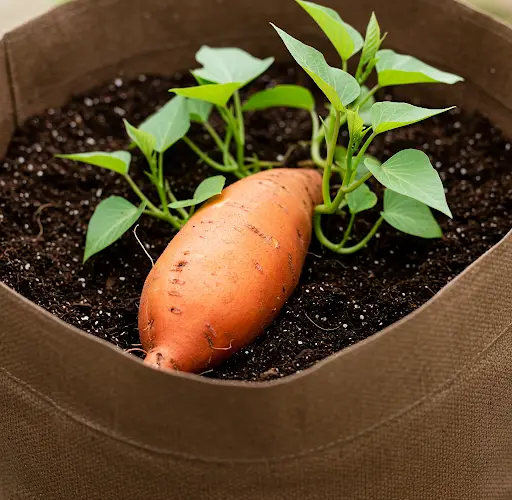Why Do Sweet Potatoes Grown in Soil Bags Have So Many Tubers?
Sweet potatoes are a nutritious and versatile crop that can be grown in various ways. However, one method that has gained popularity among gardeners is growing them in soil bags. This technique has been found to produce an abundance of tubers, often outperforming traditional in-ground planting. But what makes soil bags so effective for growing sweet potatoes? In this article, we’ll explore the reasons why soil bags encourage better tuber formation, the benefits of this method, and a step-by-step guide to growing your own bumper crop of sweet potatoes at home.
The Science Behind Sweet Potato Growth in Soil Bags
To understand why soil bags yield more tubers, let’s look at the growth requirements of sweet potatoes:
- Loose, Well-Draining Soil – Sweet potatoes thrive in aerated soil that allows easy tuber expansion.
- Consistent Moisture – Soil should retain moisture without becoming waterlogged.
- Warm Growing Environment – Sweet potatoes grow best in warm, controlled conditions.
- Minimal Root Disturbance – Less disruption leads to healthier tuber formation.
Soil bags meet all these requirements better than traditional garden beds, leading to higher yields and larger tubers. Here’s how:
- Loose soil allows tubers to expand freely, preventing deformities and crowding.
- Enhanced drainage prevents waterlogging, reducing the risk of root rot.
- The confined space directs energy into tuber production, leading to more potatoes per plant.
- Better temperature control ensures optimal growing conditions, even in cooler climates.
Key Benefits of Growing Sweet Potatoes in Soil Bags
- Higher Tuber Yield – With improved soil aeration and minimal root disturbance, the plants focus their energy on producing more tubers.
- Space Efficiency – Great for gardeners with limited space, balconies, or patios.
- Pest and Disease Control – Elevating the crop in bags reduces exposure to soil-borne pests and diseases.
- Easier Harvesting – No need for digging; simply dump the bag and collect your sweet potatoes.
- Customizable Growing Conditions – You can adjust soil composition, drainage, and sunlight exposure with ease.
How to Grow Sweet Potatoes in Soil Bags for Maximum Yield
Step 1: Choosing the Right Soil Bag
- Use a durable, breathable grow bag (10-15 gallons) or a heavy-duty plastic bag with drainage holes.
- Opt for fabric grow bags, as they allow better aeration and prevent overheating.
- If using a plastic bag, poke several holes at the bottom for proper drainage.
Step 2: Preparing the Ideal Soil Mix
For maximum tuber production, your soil should be:
- Light and well-draining – Use a mix of loamy soil, compost, and sand.
- Nutrient-rich – Add organic matter like compost or aged manure.
- Slightly acidic to neutral (pH 5.5-6.5) – Helps encourage healthy root development.
Step 3: Selecting and Preparing Sweet Potato Slips
- Obtain high-quality sweet potato slips (rooted cuttings) from a garden center or sprout them from an organic sweet potato.
- Allow slips to develop strong roots before planting.
- Soak slips in water for 24 hours to boost hydration before planting.
Step 4: Planting in Soil Bags
- Fill the soil bag three-quarters full with your prepared soil mix.
- Insert 3-4 slips per bag, spacing them at least 6 inches apart.
- Bury slips 2-3 inches deep, ensuring the roots are covered but leaves remain above soil level.
- Water thoroughly after planting.
Step 5: Caring for Your Sweet Potatoes
- Watering – Keep soil consistently moist but not soggy; water twice a week in dry conditions.
- Fertilizing – Use a low-nitrogen fertilizer (like 5-10-10) once a month to encourage root development.
- Mulching – Apply a layer of straw or dried leaves to retain moisture and regulate temperature.
- Sunlight – Place bags in a full-sun location, receiving 6-8 hours of sunlight daily.
- Temperature Control – Keep soil warm, ideally 70-85°F (21-29°C), for optimal growth.
Step 6: Harvesting Your Sweet Potatoes
- Sweet potatoes are ready for harvest in 90-120 days.
- When leaves begin to yellow and wither, it’s time to harvest.
- Simply tip over the soil bag and collect your sweet potatoes.
- Cure them for 7-10 days in a warm, dry place to enhance sweetness and improve storage life.
Common Problems and Solutions
| Problem | Cause | Solution |
|---|---|---|
| Small tubers | Overcrowding or poor soil | Space slips properly and enrich soil with compost. |
| Rotting roots | Waterlogged soil | Ensure good drainage and avoid overwatering. |
| Weak plant growth | Too much nitrogen | Use a low-nitrogen fertilizer to focus growth on tubers. |
| Pests (e.g., aphids, weevils) | Infestation | Use neem oil or insecticidal soap to protect plants. |
Alternative Containers for Growing Sweet Potatoes
While soil bags are excellent for growing sweet potatoes, you can also consider:
- Plastic buckets (with drainage holes) – Great for small spaces.
- Raised beds – Provide more room for spreading roots.
- Large wooden crates – Allow airflow and excellent drainage.
Final Thoughts
Growing sweet potatoes in soil bags is an efficient and rewarding method that yields larger and more abundant tubers compared to traditional ground planting. By using well-aerated soil, maintaining optimal moisture levels, and providing proper care, you can enjoy a bountiful harvest right at home. This technique is perfect for urban gardeners, small-space growers, or anyone looking to maximize their sweet potato production with minimal effort.
Try this method and enjoy fresh, homegrown sweet potatoes in your favorite meals!



